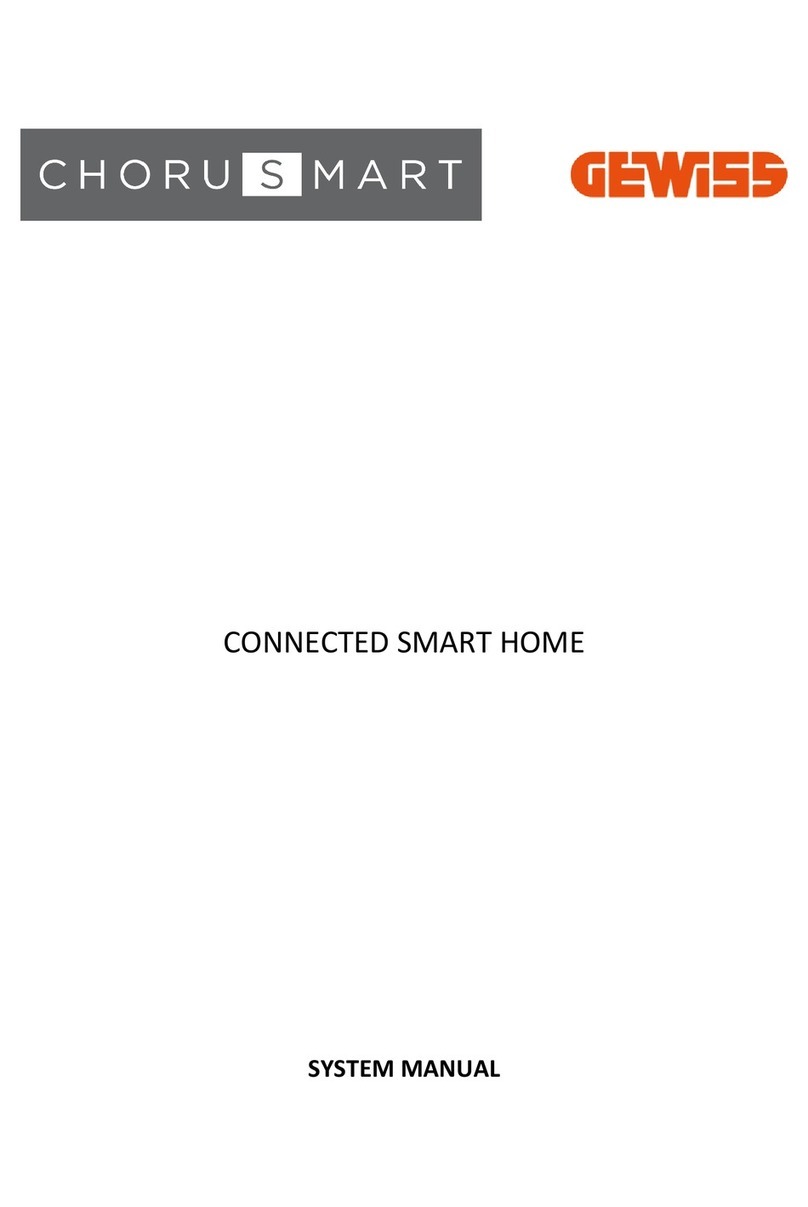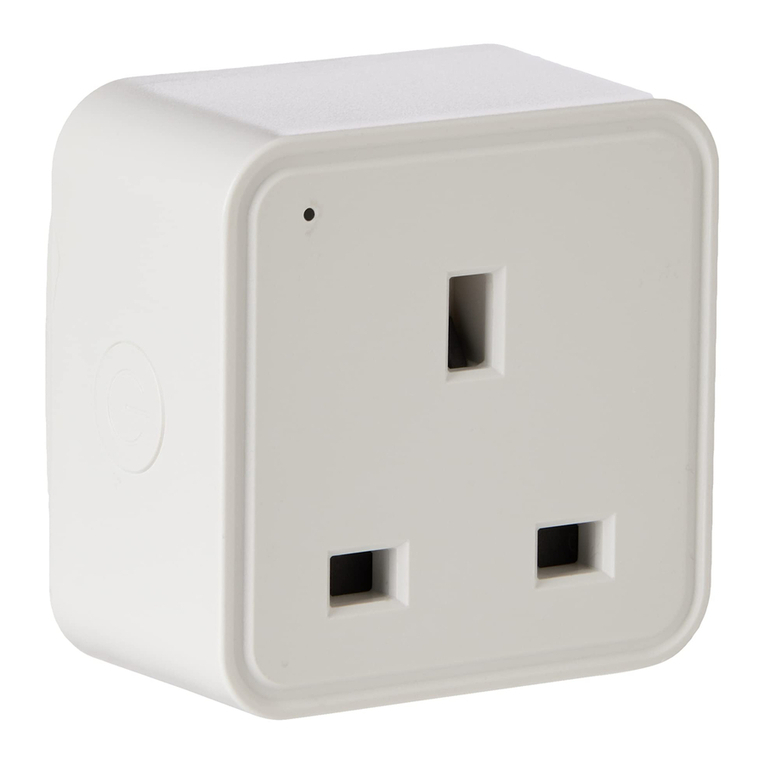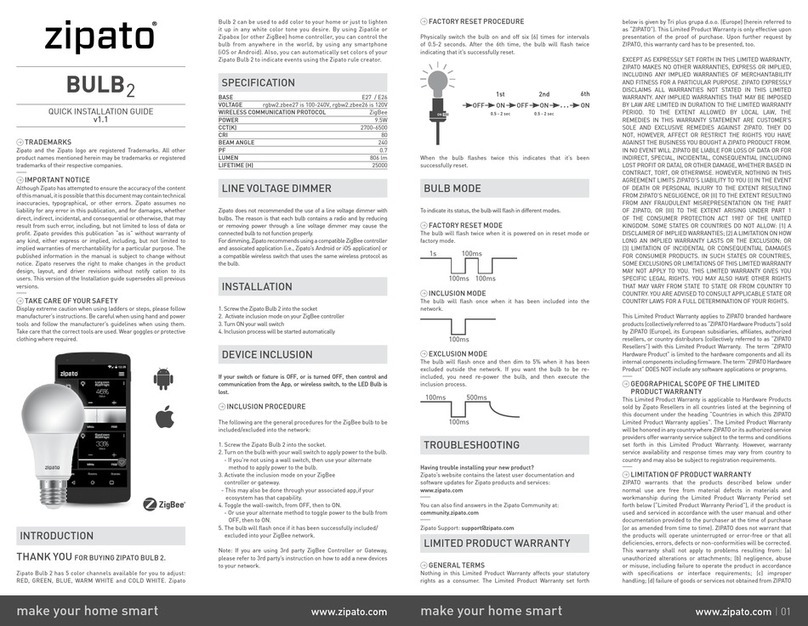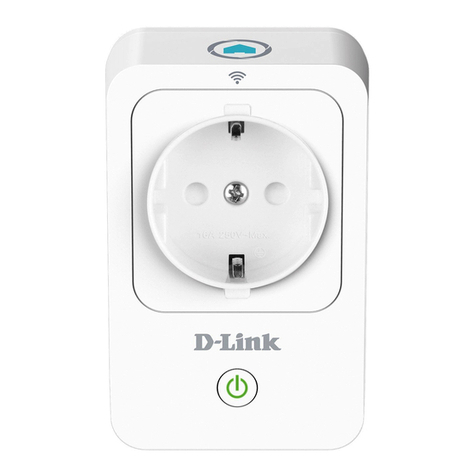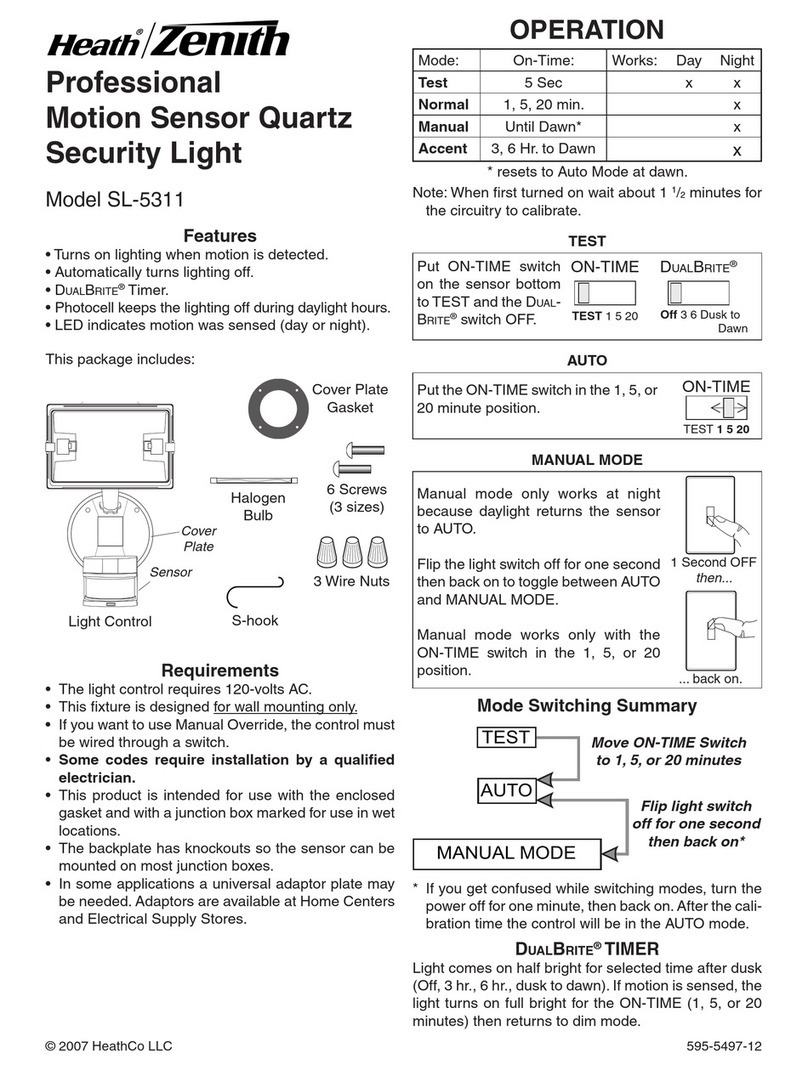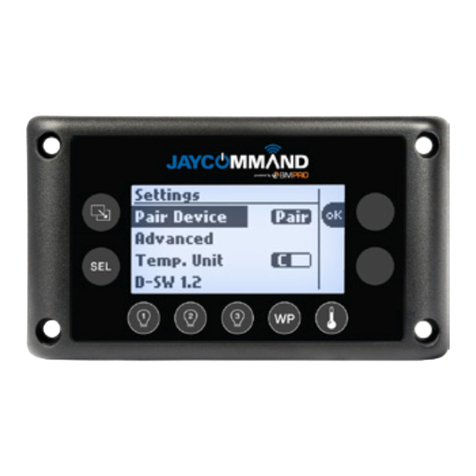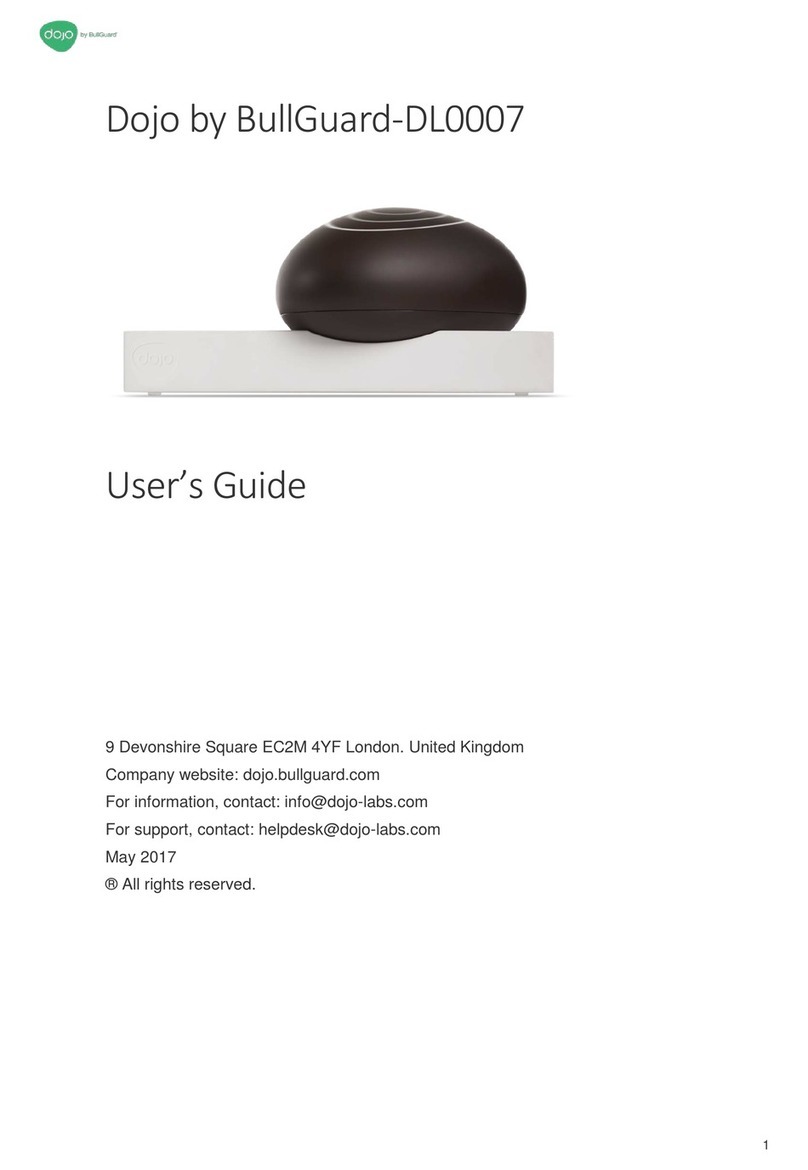tau T-WAY User manual

INSTALLATION GUIDE
T-WAY
D-MNL0TWAY 19-10-2020 - Rev.00
IT - Istruzioni originali

2
The manufacturer reserves the right to modify or improve products without prior notice. Any inaccuracies or errors found in this handbook
will be corrected in the next edition.
When opening the packing please check that the product is intact. Please recycle materials in compliance with current regulations.
This product may only be installed by a qualied tter. The manufacturer declines all liability for damage to property and/or personal
injury deriving from the incorrect installation of the system or its non-compliance with current law (see Machinery Directive).
GENERAL SAFETY RECOMMENDATIONS
Only begin to install the device after you have carefully read this instruction manual.
Both the mechanical part and the electrical part must be installed in a perfectly workmanlike manner, in compliance with the current laws in
force. Failure to comply with these latter may result in danger hazards for persons or property.
The installer must be a competent person who has been adequately trained. He must check to make sure that the structure on which the
actuator is installed is strong and stable. If necessary, structural modications must be made to strengthen it. The installer must also check
that all zones where there is a risk of crushing, dragging, shearing or other dangers, are protected by means of electronic safety devices, safety
freeboards or barriers. These devices must be installed in compliance with the current laws and in a perfectly workmanlike way, also in relation
to the place of use, the type of use and the operating logic of the product. The forces developed by the complete system as it operates must
comply with the current standards and, where this is not possible, the zones aected by these forces must be protected with electronic safety
devices. Moreover, dangerous zones must be indicated, as established by the current laws in force.
Before the actuator is connected, make sure that the electricity main possesses characteristics that are compatible with those described in
the technical specications of this manual, and that there is a dierential circuit-breaker and adequate protection against overcurrents on the
supply side of the system. Remember to turn o the power supply before installing or servicing the actuator and whenever the cover must be
opened.
Electrostatic charges can damage the electronic components on the boards. Wear a grounded antistatic bracelet if you must work on the
electronic boards. Never place the hands or other parts of the body in moving parts, such as belts, pulleys, carrelli, etc.
Servicing the actuator is of fundamental importance if the system is to operate correctly and safely. It is advisable to periodically inspect all
parts every 6 months, to make sure they operate in an ecient way.
The manufacturer declines all liability for improper installation or use of the product, or for damage deriving from unauthorized modications
to the system. Only use genuine spare parts if replacements or repairs are required. The manufacturer cannot be held liable for the way the
doors or gates to be automated are constructed, or for damages caused by failure to build the doors and gates in compliance with good
workmanlike techniques.
Protection degree IP10 requires that the actuator only be installed inside buildings. The manufacturer declines all liability for damage caused
by assembly on the outside, without adequate protections.
Always make sure that the product is in a good condition before it is installed.
This product cannot be installed in places with an explosive atmosphere or in the presence of inammable fumes or gases.
This product must be disposed of according to the current laws in force at the end of its useful life.
Do not leave parts of the product or its packaging within children’s reach, as they could become a danger hazard.
Do not stay within the door movement range and do not deliberately try to stop the door movement.
Do not allow children to stay or play within the door movement range.
MACHINE DIRECTIVE
As established by the EU commission, automated pedestrian closing systems are governed by the machine directive (2006/48/EC). This latter
species that the installer who ts a driving system on a door or gate has the same obligations as the manufacturer of the machine. Thus, he
must:
1. Prepare the technical report (complete with the documents described in annex VII of the Machine Directive).
2. Compile the relative CE conformity certicate (as per annex II-A of the Machine Directive).
3. Ax CE marking to the motorized door or gate (1.7.3, of annex I of the Machine Directive).
The installer must keep the technical report at the disposal of the competent authorities in the country for at least 10 years, running from the
date on which the motorized door or gate was manufactured.
The installer must consign the following documents to the customer:
1. Instructions on how to operate and safely use the system.
2. The routine maintenance instructions.
3. The declaration of conformity.
MAINTENANCE PROGRAM
Each 6 month:
Attention! Before work on the operator cut main power line.
- Check that all securing screws are well tightened.
- Check the tension of the belt.
- Clean the carriages sliding guide and the ground sliding guide .
- Check that carriages and wings are correctly aligned and stop are properly positioned.
- Check that elettrolock, if present, are correctly tted and that mechanical unlock system work ne.
- Check wiring connections.
- Check that door wings are stable and the movement is steady, without friction from full open to full close position.
- Check that speeds, timing, and safety functions are well set.
- lean sensors and check that safety and activation sensor are properly functioning.
Attention! Any part that appear damaged or worn must be changed.
For spare parts see the spare part list.

3
INDEX
1_ TECHNICAL FEATURES pag. 4
2_ TYPICAL SYSTEM pag. 4
3_ AUTOMATION SECTION AND REFERENCES pag. 4
4_ LEAF DIMENSIONS AND COMPONENT LAYOUT pag. 6
5_ INSTALLATION pag. 17
6_ LIMIT STOP POSITIONING ON T-WAY2S / T-WAY2D / T-WAY4 pag. 19
7_ ADJUSTMENT OF THE BELT TENSION AND EASY OPENING OF THE GUARD pag. 20
8_ ASSEMBLY OF A TWO-LEAF AUTOMATIC TELESCOPIC DOOR KIT (T-WAY2D / T-WAY2S) pag. 20
9_ ASSEMBLY OF A FOUR-LEAF AUTOMATIC TELESCOPIC DOOR KIT (T-WAY4) pag. 23
GUARANTEE pag. 26
MANUFACTURER’S DECLARATION OF INCORPORATION pag. 27
1_ CARATTERISTICHE TECNICHE pag. 4
2_ IMPIANTO TIPO pag. 4
3_ SEZIONE E RIFERIMENTI DELL’ AUTOMAZIONE pag. 4
4_ DIMENSIONE DELLE ANTE E DISPOSIZIONE COMPONENTI pag. 6
5_ INSTALLAZIONE pag. 16
6_ POSIZIONAMENTO FINECORSA SU T-WAY2S / T-WAY2D / T-WAY4 pag. 17
7_ REGOLAZIONE DELLA TENSIONE DELLA CINGHIA E APERTURA FACILITATA DEL CARTER pag. 18
8_ MONTAGGIO DI UN KIT PORTA AUTOMATICA TELESCOPICA A DUE ANTE (T-WAY2D / T-WAY2S) pag. 19
9_ MONTAGGIO DI UN KIT PORTA AUTOMATICA TELESCOPICA A QUATTRO ANTE (T-WAY4) pag. 22
GARANZIA pag. 25
DICHIARAZIONE DI INCORPORAZIONE DEL COSTRUTTORE pag. 25

4
Zona vuota Apertura carter
157.5
MIN 64.5
MIN 32
MIN 48,5 mm
MAX 66.5 mm
MIN128
MIN 824
32.5
MIN 81 - MAX 99 mm
120
23.5
40
MIN 130
MIN 154
32.5
MIN 48,5 mm
MAX 66.5 mm
MIN 250
24
MIN 186.5
23.5
120
157.5
40
TECHNICAL DATA T-WAY
Power rating 120 Watt
Max. door weight 1+1 wing 130 daN (Kg) - 2+2 wings65 daN (Kg) per wing
Opening speed 70 cm/sec (for wing)
Closing speed 60 cm/sec (for wing)
Voltage input 230 Vac ± 10% 50-60 Hz
Type of work Continuous (100%)
Operating temperature -15°C ÷ +55°C
Beam dimensions
120 x 210 mm x length max. 3000 mm
Degree of protection IP 22
Electric motor 48V DC
Ext. accessories power supply 12 e 24Vac
1. TECHNICAL FEATURES
2. IMPIANTO TIPO
3. AUTOMATION SECTION AND REFERENCES
1 Infrared sensor
2 Emergency button
3 Keypad for programming
4 Photocell (ft=transmitting ph., Fr=receiving ph.)
5 Magnetic footboard
6 Keylock selector
6
4
4
3 x 0,5
5
1
32
4 x 0,75
4 x 0,35
2 x 0,35
FT= 2 x 0,25
FR= 2 x 0,25

5
Zona vuota Apertura carter
157.5
MIN 64.5
MIN 32
MIN 48,5 mm
MAX 66.5 mm
MIN128
MIN 824
32.5
MIN 81 - MAX 99 mm
120
23.5
40
MIN 130
MIN 154
32.5
MIN 48,5 mm
MAX 66.5 mm
MIN 250
24
MIN 186.5
23.5
120
157.5
40
1. Pair of side panels 7. Complete carriage 13. Telescopic crosspiece
2. Electronic control unit 8. Door side xing 14. Main crosspiece
3. Motor unit with encoder 9. Slow leaf belt support 15. Sliding rail
4. Beam intermediate xing 10. Double pulley complete transmission 16. Guard
5. Carriage connecting bar 11. Single pulley complete transmission 17. Guard compensator prole
6. Auxiliary carriage connection 12. Anchoring prole 18. Rail seal
1
4
9
11 12
10
4
5
6
7
8
1
2
3
13
14
15
15
16
17
18
18
12
Guard opening
empty area

6
4. LEAF DIMENSIONS AND COMPONENT LAYOUT
For the door to work correctly, we recommend you comply with the measurements shown in the relative tables.
4.1 TWO-LEAF OPENING TO THE LEFT WITH ELECTRIC LOCK. LEVER RELEASE WITH BATTERY
S
LT
PL
G
LA
LEGEND:
LT = BEAM CUT LENGTH
PL = FREE PASSAGE
LA = LEAF WIDTH
G= FINAL STOP
S= LEAVES OVERLAPPING
E
B391
A
C
D
LT
LA S
PL
A Motor axle position 511 mm LT Beam cut length mm
B Control central position 70 mm PL Free passage m
C Single pulley position 707 mm LA Leaf width mm
D Double pulley position 55 mm S Leaves overlapping 23 mm
E Electric lock position 35 mm
4.2 TWO-LEAF OPENING TO THE LEFT W/O ELECTRIC LOCK. WITH BATTERY
S
LT
PL
G
LA
LEGEND:
LT = BEAM CUT LENGTH
PL = FREE PASSAGE
LA = LEAF WIDTH
G= FINAL STOP
S= LEAVES OVERLAPPING
391
A
C
LT
D
LA S
PL
A Motor axle position 441 mm LT Beam cut length mm
B Control central position 0 mm PL Free passage m
C Single pulley position 642 mm LA Leaf width mm
D Double pulley position 55 mm S Leaves overlapping 23 mm

7
4.3 TWO-LEAF OPENING TO THE LEFT WITH ELECTRIC LOCK. LEVER RELEASE WITHOUT BATTERY
S
LT
PL
G
LA
LEGEND:
LT = BEAM CUT LENGTH
PL = FREE PASSAGE
LA = LEAF WIDTH
G= FINAL STOP
S= LEAVES OVERLAPPING
LT
LA
S
E
A
B391
C
D
PL
A Motor axle position 120 mm LT Lunghezza taglio trave mm
B Control central position 295 mm PL Free passage m
C Single pulley position 718 mm LA Leaf width mm
D Double pulley position 55 mm S Leaves overlapping 23 mm
E Electric lock position 35 mm
4.4 TWO-LEAF OPENING TO THE LEFT W/O ELECTRIC LOCK. WITHOUT BATTERY
S
LT
PL
G
LA
LEGEND:
LT = BEAM CUT LENGTH
PL = FREE PASSAGE
LA = LEAF WIDTH
G= FINAL STOP
S= LEAVES OVERLAPPING
D
C
391 B
A
LC
LA S
PL
A Motor axle position 85 mm LT Beam cut length mm
B Control central position 260 mm PL Free passage m
C Single pulley position 683 mm LA Leaf width mm
D Double pulley position 55 mm S Leaves overlapping 23 mm

8
FORMULAS TO CALCULATE BEAM-LEAVES LENGTH
Calculation of LT when PL is known Calculation of PL when LT is known
LT= (3 PL - G) + S
2
PL= 2 (LT - S) + G
3
LA= (PL - G) + S
2
Below are some examples of telescopic sliding doors calculated by assuming a leaf overlap S = 23mm and a nal stop
G = 0mm each one with its relative installable accessories.

9
Dimensional table (in mm) of the telescopic doors with two leaves moving to the left:
INSTALLABLE ACCESSORIES
BEAM
LENGTH
WITHOUT
SIDE
COVERS
FREE PASSAGE
NO SEALS
LEAF WIDTH LEVER ELECTRIC
LOCK
LH METAL
RELEASE WIRE
ELECTRIC LOCK
RH PLASTIC
RELEASE WIRE
ELECTRIC LOCK
BACKUP
BATTERY
LEVER ELECTRIC
LOCK BATTERY
LH METAL
RELEASE WIRE
ELECTRIC LOCK
BATTERY
LH PLASTIC
RELEASE WIRE
ELECTRIC LOCK
BATTERY
DIMENSION
WITHOUT
RELEASE
DIMENSION
WITH METAL
LEFT-HAND
RELEASE
DIMENSION
WITH PLASTIC
RIGHT-HAND
RELEASE
LT PL LA
1300 851,3 448,7 - - - - - - - 1312 --
1350 884,7 465,3 - - - - - - - 1362 --
1400 918,0 482,0 X - - - - - - 1412 --
1500 984,7 515,3 X X - - - - - 1512 1547 -
1550 1018,0 532,0 X X - - - - - 1562 1597 -
1750 1151,3 598,7 X X - - - - - 1762 1797 -
1800 1184,7 615,3 X X X X - - - 1812 1847 1835
1950 1284,7 665,3 X X X X - - - 1962 1997 1985
2050 1351,3 698,7 X X X X X - - 2062 2097 2085
2150 1418,0 732,0 X X X X X - - 2162 2197 2185
2250 1484,7 765,3 X X X X X X -2262 2297 2285
2350 1551,3 798,7 X X X X X X X 2362 2397 2385
2550 1684,7 865,3 X X X X X X X 2562 2597 2585
2750 1818,0 932,0 X X X X X X X 2762 2797 2785
2950 1951,3 998,7 X X X X X X X 2962 2997 2985
3150 2084,7 1065,3 X X X X X X X 3162 3197 3185
3350 2218,0 1132,0 X X X X X X X 3362 3397 3385
3550 2351,3 1198,7 X X X X X X X 3562 3597 3585
3750 2484,7 1265,3 X X X X X X X 3762 3797 3785
3950 2618,0 1332,0 X X X X X X X 3962 3997 3985
4150 2751,3 1398,7 X X X X X X X 4162 4197 4185
4350 2884,7 1465,3 X X X X X X X 4362 4397 4385
4550 3018,0 1532,0 X X X X X X X 4562 4597 4585
4750 3151,3 1598,7 X X X X X X X 4762 4797 4785
4950 3284,7 1665,3 X X X X X X X 4962 4997 4985
5150 3418,0 1732,0 X X X X X X X 5162 5197 5185
5350 3551,3 1798,7 X X X X X X X 5362 5397 5385
5550 3684,7 1865,3 X X X X X X X 5562 5597 5585
5750 3818,0 1932,0 X X X X X X X 5762 5797 5785
5950 3951,3 1998,7 X X X X X X X 5962 5997 5985
6150 4084,7 2065,3 X X X X X X X 6162 6197 6185
6350 4218,0 2132,0 X X X X X X X 6362 6397 6385

10
4.5 TWO-LEAF OPENING TO THE RIGHT WITH ELECTRIC LOCK. LEVER RELEASE WITH BATTERY
S
LT
PL
G
LA
LEGEND:
LT = BEAM CUT LENGTH
PL = FREE PASSAGE
LA = LEAF WIDTH
G= FINAL STOP
S= LEAVES OVERLAPPING
EB 391
A
C
D
LT
PL
SLA
A Motor axle position 638 mm LT Beam cut length mm
B Control central position 70 mm PL Free passage m
C Single pulley position 720 mm LA Leaf width mm
D Double pulley position 55 mm S Leaves overlapping 23 mm
E Electric lock position 135 mm
4.6 TWO-LEAF OPENING TO THE RIGHT WITH BATTERY
S
LT
PL
G
LA
LEGEND:
LT = BEAM CUT LENGTH
PL = FREE PASSAGE
LA = LEAF WIDTH
G= FINAL STOP
S= LEAVES OVERLAPPING
391
A
C
D
LT
PL
SLA
A Motor axle position 568 mm LT Beam cut length mm
B Control central position 0 mm PL Free passage m
C Single pulley position 650 mm LA Leaf width mm
D Double pulley position 55 mm S Leaves overlapping 23 mm

11
4.7 TWO-LEAF OPENING TO THE RIGHT W/O ELECTRIC LOCK. WITHOUT BATTERY
S
LT
PL
G
LA
LEGEND:
LT = BEAM CUT LENGTH
PL = FREE PASSAGE
LA = LEAF WIDTH
G= FINAL STOP
S= LEAVES OVERLAPPING
PL
SLA
LT
D
A
B 391
C
A Motor axle position 178 mm LT Beam cut length mm
B Control central position 228 mm PL Free passage m
C Single pulley position 650 mm LA Leaf width mm
D Double pulley position 55 mm S Leaves overlapping 23 mm
DIMENSION WITH SIDES
Calculation of LT when PL is known Calculation of PL when LT is known
LT= (3 PL - G) + S
2
PL= 2 (LT - S) + G
3
LA= (PL - G) + S
2
Below are some examples of telescopic sliding doors calculated by assuming a leaf overlap S = 23mm and a nal stop
G = 0mm each one with its relative installable accessories.

12
Dimensional table (in mm) of the telescopic doors with two leaves moving to the right:
ACCESSORI INSTALLABILI
BEAM
LENGTH
WITHOUT
SIDE COVERS
FREE
PASSAGE
NO SEALS
LEAF
WIDTH
LEVER ELECTRIC
LOCK
LH METAL
RELEASE WIRE
ELECTRIC LOCK
RH PLASTIC
RELEASE WIRE
ELECTRIC LOCK
BACKUP
BATTERY
LEVER
ELECTRIC
LOCK BATTERY
RH PLASTIC RELEASE WIRE
ELECTRIC LOCK BATTERY
LH METAL RELEASE WIRE
ELECTRIC LOCK BATTERY
DIMENSION
WITHOUT
RELEASE
DIMENSION
WITH METAL
LEFT-HAND
RELEASE
DIMENSION
WITH PLASTIC
RIGHT-HAND
RELEASE
LT PL LA
1300 851,3 448,7 - - - - - - - 1312 --
1350 884,7 465,3 - - - - - - - 1362 --
1400 918,0 482,0 X X - - - - - 1412 -1435
1550 1018,0 532,0 X X - - - - - 1562 -1585
1700 1118,0 582,0 X X X - - - - 1712 1747 1735
1750 1151,3 598,7 X X X - - - - 1762 1797 1785
1950 1284,7 665,3 X X X - - - - 1962 1997 1985
2150 1418,0 732,0 X X X - - - - 2162 2197 2185
2200 1451,3 748,7 X X X X - - - 2212 2247 2235
2350 1551,3 798,7 X X X X - - - 2362 2397 2385
2400 1584,7 815,3 X X X X X - - 2412 2447 2435
2550 1684,7 865,3 X X X X X - - 2562 2597 2585
2600 1718,0 882,0 X X X X X X -2612 2647 2635
2700 1784,7 915,3 X X X X X X X 2712 2747 2735
2750 1818,0 932,0 X X X X X X X 2762 2797 2785
2950 1951,3 998,7 X X X X X X X 2962 2997 2985
3150 2084,7 1065,3 X X X X X X X 3162 3197 3185
3350 2218,0 1132,0 X X X X X X X 3362 3397 3385
3550 2351,3 1198,7 X X X X X X X 3562 3597 3585
3750 2484,7 1265,3 X X X X X X X 3762 3797 3785
3950 2618,0 1332,0 X X X X X X X 3962 3997 3985
4150 2751,3 1398,7 X X X X X X X 4162 4197 4185
4350 2884,7 1465,3 X X X X X X X 4362 4397 4385
4550 3018,0 1532,0 X X X X X X X 4562 4597 4585
4750 3151,3 1598,7 X X X X X X X 4762 4797 4785
4950 3284,7 1665,3 X X X X X X X 4962 4997 4985
5150 3418,0 1732,0 X X X X X X X 5162 5197 5185
5350 3551,3 1798,7 X X X X X X X 5362 5397 5385
5550 3684,7 1865,3 X X X X X X X 5562 5597 5585
5750 3818,0 1932,0 X X X X X X X 5762 5797 5785
5950 3951,3 1998,7 X X X X X X X 5962 5997 5985
6150 4084,7 2065,3 X X X X X X X 6162 6197 6185
6350 4218,0 2132,0 X X X X X X X 6362 6397 6385
6400 4251,3 2148,7 X X X X X X X 6412 6447 6435
6450 4284,7 2165,3 X X X X X X X 6462 6497 6485
6500 4318,0 2182,0 X X X X X X X 6512 6547 6535

13
4.8 4-LEAVES OPENING WITHOUT ELECTRIC LOCK. WITHOUT BATTERY
LT
LA
PL
S
SG
LEGEND:
LT = BEAM CUT LENGTH
PL = FREE PASSAGE
LA = LEAF WIDTH
G= FINAL STOP
S= LEAVES OVERLAPPING
PL
LA S
D
A
B391
C
LT
38 38
76
A Motor axle position 85 mm LT Beam cut length mm
B Control central position 260 mm PL Free passage m
C Single pulley position 683 mm LA Leaf width mm
D Double pulley position 55 mm S Leaves overlapping 23 mm
4.9 4-LEAVES OPENING WITHOUT ELECTRIC LOCK. WITH BATTERY
LT
LA
PL
S
SG
LEGEND:
LT = BEAM CUT LENGTH
PL = FREE PASSAGE
LA = LEAF WIDTH
G= FINAL STOP
S= LEAVES OVERLAPPING
FG
F
G
D
C
A
391
LA
S
PL
LT
76
20
20
A Motor axle position 441 mm LT Beam cut length mm
B Control central position 0 mm PL Free passage m
C Single pulley position 646 mm LA Leaf width mm
D Double pulley position 55 mm S Leaves overlapping 23 mm

14
4.10 CARRIAGE CONNECTION BAR FOR T-WAY WITH 4 MOBILE LEAVES
LR
LF
7 7
The T-WAY operating unit with 4 mobile leaves provides for the use of a connection bar xed between the left support carriage of the slow
moving leaf on the right side of the beam and a special return carriage connected to the traction belt.
The carriage connection bar must be cut and drilled following the dimensions shown in the gure above and xed to the carriages using the
screws.

15
Dimensional table (in mm) of the telescopic doors with four moving leaves:
ACCESSORI INSTALLABILI
BEAM LENGTH WITHOUT SIDE
COVERS
FREE PASSAGE NO SEALS LEAF WIDTH LENGTH OF THE
CONNECTING BEAM
HOLE SPACING OF THE
CONNECTING BEAM
BATTERY ELECTRIC LOCK DIMENSION WITH SIDES
LT PL LA LR LF
2500 1636,0 432,0 288 274 - - 2512
2550 1669,3 440,3 296 282 - - 2562
2750 1802,7 473,7 330 316 - - 2762
2950 1936,0 507,0 363 349 - - 2962
3150 2069,3 540,3 396 382 - - 3162
3350 2202,7 573,7 430 416 X -3362
3550 2336,0 607,0 463 449 X-3562
3750 2469,3 640,3 496 482 X - 3762
3950 2602,7 673,7 530 516 X - 3962
4150 2736,0 707,0 563 549 X-4162
4350 2869,3 740,3 596 582 X -4362
4550 3002,7 773,7 630 616 X -4562
4750 3136,0 807,0 663 649 X- 4762
4950 3269,3 840,3 696 682 X - 4962
5150 3402,7 873,7 730 716 X-5162
5350 3536,0 907,0 763 749 X-5362
5550 3669,3 940,3 796 782 X-5562
5750 3802,7 973,7 830 816 X - 5762
5950 3936,0 1007,0 863 849 X- 5962
6150 4069,3 1040,3 896 882 X -6162
6350 4202,7 1073,7 930 916 X-6362
6500 4302,7 1098,7 955 941 X-6512
DIMENSION WITH SIDES
Calculation of LT when PL is known Calculation of PL when LT is known
LT= PL - G + 4S
2
PL= 2 LT + G - 4S
3
LA= PL - G + S
4
LR = LA - S - 121
LF = LA - S - 135
Below are some examples of telescopic sliding doors calculated by
assuming a leaf overlap S = 23mm and a nal stop
G = 0mm each one with its relative installable accessories

16
5. INSTALLATION
5.1
REAR CROSSPIECE ANCHORING
The crosspiece must be xed to a at surface, solid enough for the weight of the leaves that will be used. If the wall or support you
are using does not meet these characteristics, a suitable iron tube must be adopted as the crosspiece is not self-supporting.
We recommend you use a spirit level to avoid an assembly not level with the crosspiece.
- Fasten the anchoring prole (g. 1) to the wall or support using M8 steel plugs and equivalent. The xing points must be distributed
every 600 mm.
- Undo the screws connecting the transmission belts to the carriages. (g. 2)
- Unscrew the end and intermediate screws and separate the front beam from the rear beam. (g. 3)
At this point, drill the beam from behind by placing it on two trestles so as not to compromise the sliding track. The xing points
must be distributed every 600 mm.
- Position the rear beam on the xing prole and anchor it to the wall with screws and plugs. (g. 4)
During the drilling of the beam and the wall, be careful not to damage the sliding track (C) as it would compromise the
operation and quietness of the automation.
Once the beam has been xed, clean the sliding area aected by the drilling residues using a brush or a small
vacuum cleaner.
If there are obstacles to the right or left of the automatic door, t the side caps (D) before xing the beam to the
wall.
Fig. 1
Fig. 2 Fig. 3
Fig. 4
5.2
ANCHORING THE LEAVES TO THE CARRIAGES AND ADJUSTMENT
1) Unscrew the two screws (A) of each carriage and remove its mobile part (C) as described in gure 5A.
2) Fasten the moving parts (C) to the sliding leaves on the leaf opening side.
N.B.: In order to allow the leaves to overlap correctly, these moving parts must be xed at a distance of 95 mm from the edge
of the leaf opening side as described in gure 5B.
3) Fasten the moving parts (C) to the sliding leaves on the leaf-closing side.
N.B.: Compatibly with the accessories installed, x the moving parts at a distance from the closing side edge as much as
possible equal to the opening side ones, so as to obtain a good balance of the leaf weight on the carriages;
4) Hang the leaves on the carriages and screw the screws (A) in without tightening them.

17
5) Once the desired height of the leaf has been adjusted using the adjusting screw (B) tighten the two screws (A).
For the automation to operate correctly, it is important that the mobile leaf is perpendicular to the crosspiece.
For a good functioning of the automation it is important that the mobile leaf is perpendicular to the crosspiece.
B
C
A
g. 5A
PROFILO REGGIANTA
18,5
56,5
24
10 min.
11 max.
163
95
163
95
g. 5B
Anta lenta
Anta veloce
5.3
FRONT CROSSPIECE ANCHORING
Position the front beam on the rear beam and secure it with the end and intermediate screws (Fig. 6)
Then retighten the screws connecting the transmission belts to the carriages (g. 2) and nally t the adjustable brackets of the
carriages on the front leaves and then fasten them to the carriages of the front beam (g. 5)
g. 6
A
A
B
B
6. LIMIT STOP POSITIONING ON T-WAY2S / T-WAY2D / T-WAY4
The braking pads must be adjusted so that both of them, in the closing and in the opening phase, block the carriages before the
mobile leaf impacts anything else (the wall, a window etc.). They are also used by the microprocessor to acquire the limit stop
position in case the mains voltage fails and the battery is not inserted.

18
When adjusting the brake pad during opening, keep in mind that during normal operation, the moving leaf stops
5 mm before impacting the pad (excluding the rst manoeuvre after a power failure).
6.1 OPENING LIMIT STOP T-WAY2S - T-WAY2D - T-WAY4(g. 7A)
1) Fix the appropriate limit stops on the mobile carriages.
2) Adjust the position of the closing limit stop by loosening the nut.
3) Adjust the pad to the desired position and tighten the nut.
6.2 CLOSING LIMIT STOP T-WAY2S - T-WAY2D W/O ELECTRIC LOCK (g. 7B)
1) Fix the appropriate limit stops on the mobile carriages.
2) Adjust the position of the closing limit stop by loosening the screws.
3) Move it to the desired position and tighten the screws.
6.3 CLOSING LIMIT STOP T-WAY2S - T-WAY2D WITH ELECTRIC LOCK (FIG. 7C) (g. 7C)
1) Fix the appropriate limit stops on the mobile carriages.
2) Adjust the position of the carriage until it rests on the electric block body.
6.4 CLOSING LIMIT STOP T-WAY4 (g. 7D)
1) Fix the appropriate limit stops on the mobile carriages.
2) Adjust the position of the closing limit stop pads by loosening the screws.
3) Move them to the desired position.
A
12345678
B
C
D
E
F
12345678
A
B
C
D
E
F
A2
FINECORSA DI CHIUSURA T-WAY2S - T-WAY2D SENZA ELETTROBLOCCO
REGOLARE LA POSIZIONE DEL FINECORSA DI CHIUSURA ALLENTANDO LE VITI E
SPOSTARLO NELLA POSIZIONE DESIDERATA E SERRARE LE VITI
FINECORSA DI APERTURA T-WAY2S - T-WAY2D - T-WAY4
REGOLARE LA POSIZIONE DEL FINECORSA DI CHIUSURA ALLENTANDO IL DADO
REGOLARE IL TAMPONE NELLA POSIZIONE DESIDERATA E SERRARE IL DADO
FINECORSA DI CHIUSURA T-WAY2S - T-WAY2D CON ELETTROBLOCCO
REGOLARE LA POSIZIONE DEL CARRELLO FINO AD APPOGGIARLO AL CORPO
ELETTROBLOCCO.
FINECORSA DI CHIUSURA T-WAY4
REGOLARE LA POSIZIONE DEI TAMPONI FINECORSA DI CHIUSURA ALLENTANDO LE VITI E
SPOSTANDOLI NELLA POSIZIONE DESIDERATA
g. 7A g. 7B
A
12345678
B
C
D
E
F
12345678
A
B
C
D
E
F
A2
FINECORSA DI CHIUSURA T-WAY2S - T-WAY2D SENZA ELETTROBLOCCO
REGOLARE LA POSIZIONE DEL FINECORSA DI CHIUSURA ALLENTANDO LE VITI E
SPOSTARLO NELLA POSIZIONE DESIDERATA E SERRARE LE VITI
FINECORSA DI APERTURA T-WAY2S - T-WAY2D - T-WAY4
REGOLARE LA POSIZIONE DEL FINECORSA DI CHIUSURA ALLENTANDO IL DADO
REGOLARE IL TAMPONE NELLA POSIZIONE DESIDERATA E SERRARE IL DADO
FINECORSA DI CHIUSURA T-WAY2S - T-WAY2D CON ELETTROBLOCCO
REGOLARE LA POSIZIONE DEL CARRELLO FINO AD APPOGGIARLO AL CORPO
ELETTROBLOCCO.
FINECORSA DI CHIUSURA T-WAY4
REGOLARE LA POSIZIONE DEI TAMPONI FINECORSA DI CHIUSURA ALLENTANDO LE VITI E
SPOSTANDOLI NELLA POSIZIONE DESIDERATA
g. 7C
A
12345678
B
C
D
E
F
12345678
A
B
C
D
E
F
A2
FINECORSA DI CHIUSURA T-WAY2S - T-WAY2D SENZA ELETTROBLOCCO
REGOLARE LA POSIZIONE DEL FINECORSA DI CHIUSURA ALLENTANDO LE VITI E
SPOSTARLO NELLA POSIZIONE DESIDERATA E SERRARE LE VITI
FINECORSA DI APERTURA T-WAY2S - T-WAY2D - T-WAY4
REGOLARE LA POSIZIONE DEL FINECORSA DI CHIUSURA ALLENTANDO IL DADO
REGOLARE IL TAMPONE NELLA POSIZIONE DESIDERATA E SERRARE IL DADO
FINECORSA DI CHIUSURA T-WAY2S - T-WAY2D CON ELETTROBLOCCO
REGOLARE LA POSIZIONE DEL CARRELLO FINO AD APPOGGIARLO AL CORPO
ELETTROBLOCCO.
FINECORSA DI CHIUSURA T-WAY4
REGOLARE LA POSIZIONE DEI TAMPONI FINECORSA DI CHIUSURA ALLENTANDO LE VITI E
SPOSTANDOLI NELLA POSIZIONE DESIDERATA
g. 7D
A
12345678
B
C
D
E
F
12345678
A
B
C
D
E
F
A2
FINECORSA DI CHIUSURA T-WAY2S - T-WAY2D SENZA ELETTROBLOCCO
REGOLARE LA POSIZIONE DEL FINECORSA DI CHIUSURA ALLENTANDO LE VITI E
SPOSTARLO NELLA POSIZIONE DESIDERATA E SERRARE LE VITI
FINECORSA DI APERTURA T-WAY2S - T-WAY2D - T-WAY4
REGOLARE LA POSIZIONE DEL FINECORSA DI CHIUSURA ALLENTANDO IL DADO
REGOLARE IL TAMPONE NELLA POSIZIONE DESIDERATA E SERRARE IL DADO
FINECORSA DI CHIUSURA T-WAY2S - T-WAY2D CON ELETTROBLOCCO
REGOLARE LA POSIZIONE DEL CARRELLO FINO AD APPOGGIARLO AL CORPO
ELETTROBLOCCO.
FINECORSA DI CHIUSURA T-WAY4
REGOLARE LA POSIZIONE DEI TAMPONI FINECORSA DI CHIUSURA ALLENTANDO LE VITI E
SPOSTANDOLI NELLA POSIZIONE DESIDERATA
7. ADJUSTMENT OF THE BELT TENSION AND EASY OPENING OF THE GUARD
o adjust the tension of the slow leaf belt (g. 8), loosen the xing screws of the two-pulley tightener, then act on the
adjustment screw and tighten the screws
To adjust the tension of the slow leaf belt (g. 9), loosen the xing screws of the single-pulley tightener, act on the adjustment
screw and tighten the screws
For a correct belt tension always tighten the fast leaf belt rst and the slow leaf belt later
Facilitated opening for maintenance.
Open the guard and position it in the appropriate seat as in gure 10.

19
TENSIONAMENTO CINGHIE
N.B. PER UN CORRETTO TENSIONAMENTO CINGHIE TENSIONARE SEMPRE
PRIMA LA CINGHIA VELOCE E POI LA CINGHIA LENTA
PER TENSIONARE LA CINGHIA ANTA VELOCE ALLENTARE LE VITI DI
FISSAGGIO DEL TENDITORE A DUE PULEGGE, AGIRE SULLA VITE DI
REGOLAZIONE E SERRARE LE VITI
PER TENSIONARE LA CINGHIA ANTA LENTA ALLENTARE LE VITI DI
FISSAGGIO DEL TENDITORE A PULEGGIA SINGOLA, AGIRE SULLA
VITE DI REGOLAZIONE E SERRARE LE VITI
g. 8
TENSIONAMENTO CINGHIE
N.B. PER UN CORRETTO TENSIONAMENTO CINGHIE TENSIONARE SEMPRE
PRIMA LA CINGHIA VELOCE E POI LA CINGHIA LENTA
PER TENSIONARE LA CINGHIA ANTA VELOCE ALLENTARE LE VITI DI
FISSAGGIO DEL TENDITORE A DUE PULEGGE, AGIRE SULLA VITE DI
REGOLAZIONE E SERRARE LE VITI
PER TENSIONARE LA CINGHIA ANTA LENTA ALLENTARE LE VITI DI
FISSAGGIO DEL TENDITORE A PULEGGIA SINGOLA, AGIRE SULLA
VITE DI REGOLAZIONE E SERRARE LE VITI
g. 9 g. 10
8. ASSEMBLY OF A TWO-LEAF AUTOMATIC TELESCOPIC DOOR KIT (T-WAY2D, T-WAY2S) FIG. 11
The following images show the assembly sequence for a door opening to the left.
The principle is equally valid also for doors opening to the right
1) Cut the rear beam (LT) to size and drill the holes as in gure 11-A.
2) Insert the intermediate beam fastenings and x them with the screws in positions equidistant from each other and from the
ends (g.11-B)
3) Fit the noise protection prole and the sliding rail on the rear beam. Insert the rear leaf carriages and the right and left side
beam fastenings, then lock them in position with the lower and rear screws. (g.11-C)
4) Fasten the connection bracket to the outermost carriage (g. 11-D)
5) Cut the front beam (LT) to size and drill the end and intermediate holes. Then drill the ares as shown in gure 11-E
The intermediate holes must match the intermediate beam fastenings
6) Fit the noise protection prole and the sliding rail on the rear beam. Next fasten the front beam to the rear one and tighten
all the screws properly. (g. 11-F)
7) Prepare the front leaf carriages tting the opening limit stop extension and if necessary the leaf locking bracket (for versions
with electric lock), then insert them into the front beam. (g. 11-G)
The locking bracket is tted only in the versions with electric lock
8) Install the gearmotor, control unit, pulley transmissions, belts and accessories on the front beam according to the conguration
of the t-way door, see assembly diagrams (paragraph 4) (g. 11-H)
- Fit the tightener and the two-belt pulley transmission by inserting them in the track and tightening the screws (g. 11-H.1)
- Fit the tightener and the slow leaf belt pulley transmission by inserting them in the track and tightening the screws (g. 11-H.2)
- Fit the gearmotor as shown in gure 11-H.3
- Fit the control unit as shown in gure 11-H.4
- Fit the electric lock and related manual release accessories 11-H.5
Assembly of opening limit stop with rail stop and closing limit stop 11-H.6
9) Fast leaf belt installation (g. 11-i)
- Fasten the belt support bracket to the outermost carriage as shown in gure 11-i.1
- Wrap the edges of the belt around the motor pulley, around the large pulley of the double pulley transmission and
secure it to the carriage using the toothed bracket (g. 11- i.2). Then bring the external carriage to the opening limit stop.
110) Installing the slow leaf belt (g. 11-J)
-Wrap the edges of the belt around the small pulley of the double pulley transmission and around the pulley of the single
pulley transmission. Fasten the belt with the front carriage to the opening limit stop using the belt joint. (g. 11-J.1)
Fasten the belt joint as close as possible to the single pulley transmission
- Fit the slow leaf belt connection bracket (g, 11-J.2)
- Fasten the belt using the special toothed xing bracket. Then lock the belt on the carriage taking care to keep the two
front and rear carriages well aligned (g. 11-J.3)
11) Fit the side covers or the manual release accessories (g. 11-K)

20
15.5
50
56
8.5
LT
23.5 32.5
56
15.5
°09
g. 11-A
15.5
50
56
8.5
LT
23.5 32.5
56
15.5
°09
g. 11-B
15.5
50
56
8.5
LT
23.5 32.5
56
15.5
°09
g. 11-C
g. 11-F
15.5
50
56
8.5
LT
23.5 32.5
56
15.5
°09
15.5
50
56
8.5
LT
23.5 32.5
56
15.5
°09
g. 11-D
g. 11-E
End holes Intermediate holes
Table of contents
Popular Home Automation manuals by other brands
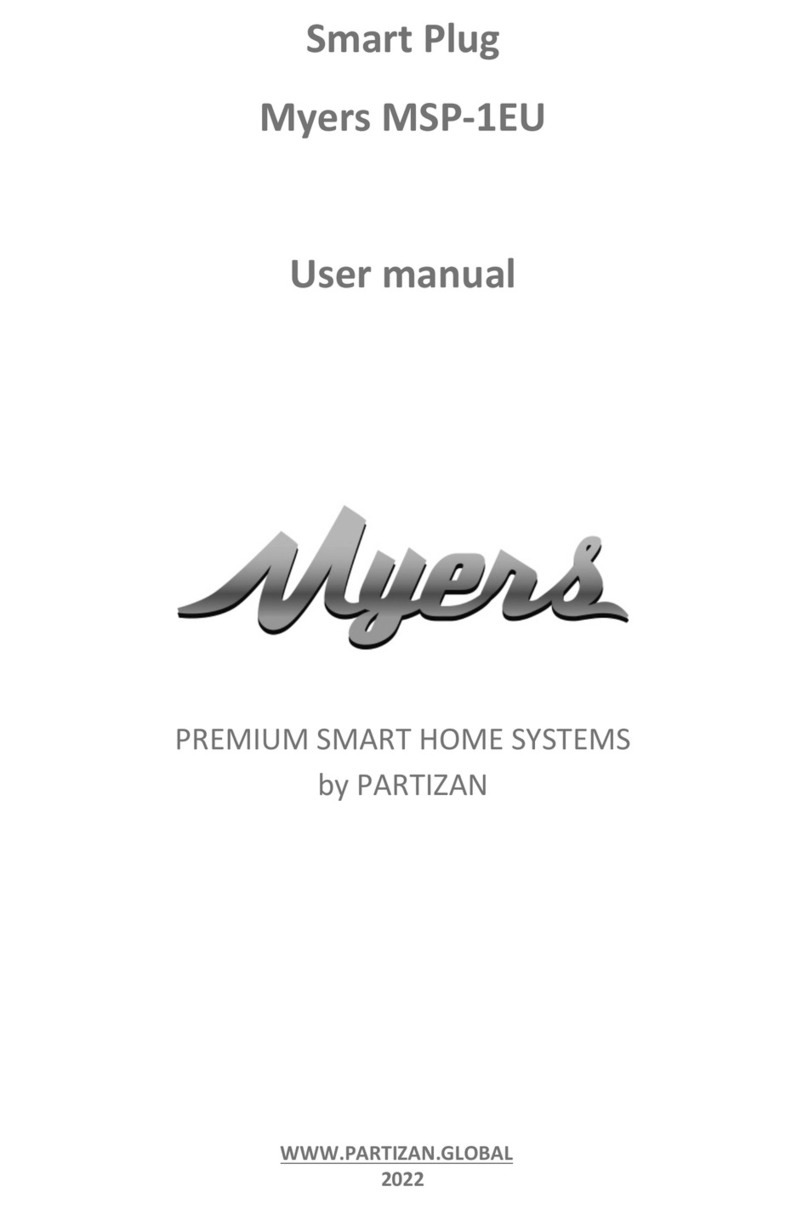
Partizan
Partizan Myers MSP-1EU user manual

Hama
Hama 00176552 operating instructions

Geti
Geti GSS01 instruction manual
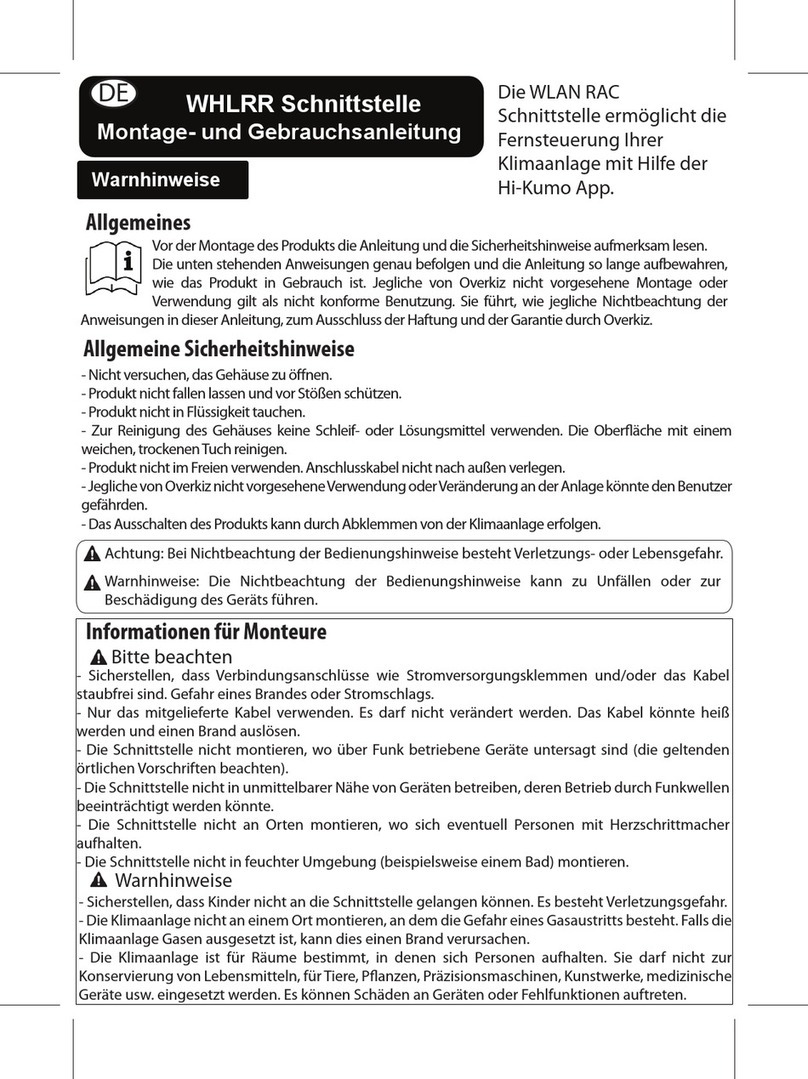
Overkiz
Overkiz WHLRR Operating and installation guide

iDevices
iDevices Wall Switch Installation & setup guide

Planet Networking & Communication
Planet Networking & Communication HTS-1000P Quick installation guide
